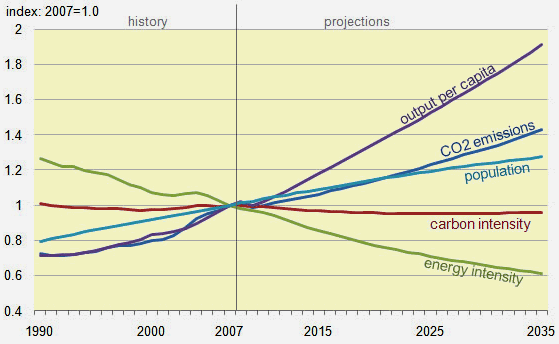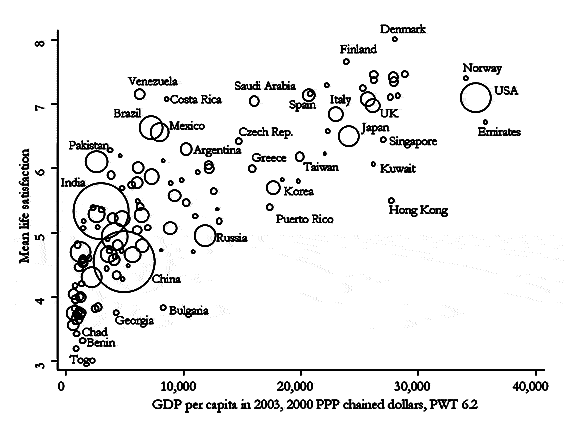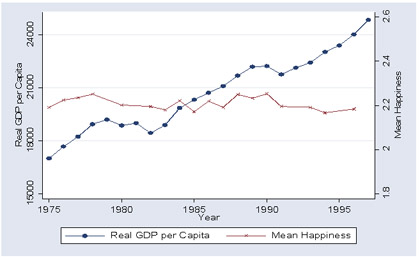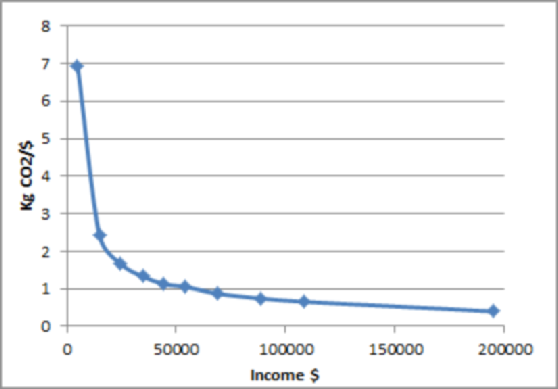Disclaimer: The first two parts of this article were published in the Skeptical Science blog. Parts 3-5 justify the arguments further and discuss the implications of changing income inequality on carbon emissions and human welfare. These additional sections should be regarded as the opinions of the author, and do not necessarily represent the views of Skeptical Science.
Economic Growth and Climate Change
Part 1- Factors Influencing CO2 Emissions
Environmentalists have long argued that we should adopt more sustainable models of living due to the limitations of natural resources and the environmental problems resulting from their exploitation. Probably the most serious environmental threat is climate change caused mostly by human activity in the form of greenhouse gases. We are currently on track for a warming of between 4.1 to 7.1 deg C by 2100 according to the Hadley centre predictions. This level of temperature rise would threaten the stability of the global ecosphere as we know it.
The concentration of the most important anthropogenic greenhouse gas carbon dioxide (CO2) has been steadily increasing in the atmosphere since the 19th century, with the rate of emissions of this gas from human activities increasing by 45% between 1990 and 2010, and fossil fuel combustion being mainly responsible.
The so-called Kaya identity can be used to conveniently describe the key factors which determine fossil fuel CO2 emissions from an economic perspective:
CO2 ≡ population x [energy/GDP] x [CO2/energy] x [GDP/population]
Where energy refers to primary energy, energy/GDP is called the energy intensity, CO2/energy the carbon intensity, GDP/population is (economic) output per capita and GDP per population the economic output per population and GDP the gross national product. So this identity reduces to:
CO2 ≡ population x energy intensity x carbon intensity x output per capita
We shall briefly consider the potential for reductions in each one of these terms, although these can be interdependent.
Population
The InterAcademy Panel Statement on Population Growth, which was ratified by 58 member national academies in 1994, called the growth in human numbers "unprecedented", and stated that many environmental problems, such as rising levels of atmospheric carbon dioxide, global warming, and pollution, were aggravated by the population expansion.
Over most most of human history, high birth rates have almost been balanced by death rates. However, as agriculture, sanitation and medicine improved, death rates, and particularily infant mortality reduced leading to a rapid population expansion. More recently the global fertility rate (the number of children born per female) has fallen rapidly, halving between 1950-1955 and 2000-2005 to 2.65. Unfortunately, this reduction will take some time to fully feed through to birth rates since fertility rates are also dependent upon the proportion of women of child bearing age which is higher in a rising population. Therefore, global population is still expected to grow substantially before peaking. According to United Nation estimates it may have recently passed 7 billion and could reach 10.1 billion by 2100.
Whilst a reduction in fertility due to family planning and cultural changes have been partially successful in many developing countries, these changes have generally not been extended to Africa, and some Middle Eastern states, which still exhibit very high fertility rates. These countries may produce little fossil fuel based CO2 at present, but they can still contribute appreciably to other global warming pollutants such as black carbon and methane. Their populations may also aspire to the standards of the richest countries, potentially storing up severe environmental problems for the future.
A number of practical and moral factors restrict interventionist measures for controlling population growth. First of all sustained increases in longevity increases population. Secondly because the number of births per population tends to lag fertility changes. To halt population growth quickly it would be necessary to initially restrict fertility rates to well below two, which is a difficult policy to enforce. Even in authoritarian countries such as China, where this policy has been successfully used to control population, this can lead to social and economic problems due to the lack of young people to support the old in subsequent generations.
Energy Intensity [primary energy/GDP]
Energy intensity can be thought of as the efficiency we can turn primary energy into GDP. Methods of reducing energy intensity include improving thermodynamic or process efficiencies, such as increasing industrial plant and commercial building insulation properties. This shouldn’t be confused with simply using less energy, since some changes could reduce GDP by still more and therefore increase energy intensity.
The efficiency at which certain energy processes can be improved is at least at a basic level, limited by thermodynamic laws, however, changing the nature of economic activity is not subject to these limitations. For example, intellectual property would require very little energy whilst contributing to GDP.
Economic status strongly influences energy intensity. Generally countries with dominant, high value service economies such as Switzerland have a low energy intensity, whilst major petroleum economies such as Canada, Russia and Saudi Arabia have a high energy intensity. However, some developing countries such as Bangladesh have the lowest energy intensity of all since they are very efficient at translating energy into GDP.
Many developed economies have reduced their production based energy intensity as they introduced more efficient industry and moved towards a service economy importing products from abroad. However, when measured on a consumption basis this is usually higher.
Some economists have proposed that increasing energy efficiency makes the use of energy relatively cheaper thereby fuelling economic growth, which could lead to increased use of energy and emissions of CO2. One version of this theory is sometimes better known as the Jeavons paradox. The degree of this rebound effect is uncertain but it can’t be ignored entirely, so efficiency improvements may have to be used in conjunction with taxes or emission caps to limit any significant effect.
Carbon Intensity [CO2/primary energy]
Large reductions in the carbon intensity of energy use can be made by switching to lower carbon fuels, such as from coal to natural gas, or from natural gas to nuclear, and renewable technologies. Other greenhouse gases such as Nitrous Oxide and Methane, which can be translated to equivalent units of CO2 global warming potential, can also be reduced by changing agricultural processes.
Countries tend to use the cheapest energy source available, which unfortunately for the two largest CO2 emitters, the USA and China is high carbon coal, and there appears to be substantial reserves of this fuel left. Fitting carbon capture and sequestering technology to coal power stations would reduce the carbon intensity of GDP by reducing carbon and increasing energy. Of course this might increase the economic output/population term as well, reducing some of the benefit.
Cheap resources of crude oil are becoming more scarce which is leading to the extraction of oil from unconventional sources such as oil shale. This is generally much more carbon intensive than crude oil.
Replacing petroleum with some first generation biofuels has also resulted in increased carbon intensity of energy use relative to fossil fuels due to the effects of deforestation for plantations, and emissions from nitrogen fertilisers. However, biofuels made from sugar cane, lignocellulosic feedstock and biogas from anaerobic digestion can reduce the carbon intensity of energy use relative to petroleum fuels.
Output per Capita [GDP per population]
The output of an economy is sometimes measured in terms of the Gross Domestic product (GDP) whilst Output per capita is often considered an indicator of a country's standard of living.
The countries with the highest GDP per capita have historically been generally concentrated in three main economic blocs, the US, the European Union and Japan which between them have been responsible for the majority of global CO2 emissions. However, the expanding economies of China, Brazil and India have more recently become major emitters. This is due to their population size combined with a rapid increase in economic growth, although their output/capita has still a long way to grow before they reach the levels of fully developed economies. It is possible this will be repeated for the rest of the developing world later this century unless economic growth becomes limited by resources or environmental factors.
Economic growth dominates contemporary political and economic thinking, and this is reflected in our consumer oriented culture. Businesses attempt to expand, and individuals are encouraged to work longer to earn and consume more. Since world economies are so dependent upon fossil fuels for energy, fertilisers and a wide range of synthetic consumer products increases in CO2 emissions have historically been correlated with economic growth.
In part 2 of this series we shall examine whether we can meet recommended CO2 targets by reducing the energy and carbon intensity alone as most economists and politicians desire, or whether we need to target economic growth as well.
Part 2 - Sustainable Growth - An Economic Oxymoron?
In part 1 we examined the principal economic factors which determine anthropogenic CO2 emissions from the combustion of fossil fuels. In this section we examine the potential for reductions in each of these terms.
As a reminder the economic factors determining CO2 can be described by the Kaya identity:
CO2 ≡ population x [energy/GDP] x [CO2/energy] x [GDP/population]
Where energy refers to primary energy, energy/GDP is called the energy intensity, CO2/energy the carbon intensity, GDP/population is (economic) output per capita and GDP the gross national product. So this reduces to:
CO2 ≡ population x energy intensity x carbon intensity x output per capita
The global trends in each of these terms from 1990 to 2007 and projections from 2007 to 2035 assuming a business as usual scenario are illustrated below.

Source: International Energy Outlook 2010 (original source: US Energy Administration Information)
Between 2007 and 2035, energy intensity is expected to reduce by about 39% whilst global carbon intensity is expected to drop by as little as 4%. In contrast population is expected to increase by 27% whilst economic output per capita is expected to increase by an alarming 91%. These factors together will increase CO2 emissions by around 42%. It appears that if we carry on as normal, economic growth will swamp any benefit attained though technological advances, resulting in a substantial increase in CO2.
To meet CO2 targets, mainstream politicians and economists such as Nicolas Stern talk about ‘decoupling the relationship between carbon emissions and economic growth by reducing carbon and energy intensity so we can carry on increasing GDP. Stern estimated in 2006 that the“the annual costs of achieving stabilisation between 500 and 550ppm Carbon dioxide equivalent (CO2e) is around 1% of global GDP, if we start to take strong action now.
However, this CO2 concentration is too high. A stabilisation target of 450 parts per million CO2e is more widely regarded as being synonymous with with keeping global temperatures by 2100 at no more than 2 degrees Celsius above pre-industrial temperatures. Exceeding this would likely result in severe consequences on human and ecological systems, although even this concentration may be too high. The figure of 450ppm CO2e requires that developed countries need to reduce GHG emissions 25 - 40% below 1990 levels by 2020, and 80-95% below 1990 levels by 2050.(1)
Not surprisingly, a number of academics have suggested that economic growth is the main factor which needs to be addressed. For example, Professor Tim Jackson considers that economic growth “is totally at odds with the finite resource base and the fragile ecology on which we depend for survival”. In his book ‘Prosperity Without Growth’ Jackson calculates how much we would need to reduce the product of energy intensity and carbon intensity (in units of CO2e/economic output) to meet the IPCC recommendations of 450 ppm by 2050, without adjusting GDP or population growth rates. Evidently, in the absence of such controls, we would need to reduce this factor by 10 times faster than the present rate, that is a 21 fold improvement by that date relative to the present to meet this target! Some other scenarios regarding population or GDP growth would require a virtual complete de-carbonisation of our entire energy system!
Recent evidence suggests that there has been limited ‘progress’ in reducing CO2 except a unintended temporary drop in 2009 which interestingly coincided with a reduction in GDP in the developed world, with the upward trend resuming in 2010 whilst it is difficilt for developing economies to reduce CO2 in absolute terms it is more reasonable to expect that their CO2/GDP reduces as inefficient industries are improved or replaced. However, even these hopes were dashed in the case of China when a recent study suggested that the downward trend in this metric had reversed. To underline these figures a statement at the 2009 Copenhagen Climate Science Congress, said that "recent observations confirm that, given high rates of observed emissions, the worst-case IPCC scenario trajectories (or even worse) are being realized."
There are also non-climate related factors to consider when examining the implications of economic growth. These include our finite resource limits, local ecological impacts, and in affluent nations the limited societal benefits of increasing incomes still further.
In conclusion, it seems that our present economic policies seem to place far too much reliance on technology to stand a reasonable chance of meeting future greenhouse gas targets in time. In view of the rapid pace of climate change, the risk of passing critical tipping points, and the immense potential for increased global greenhouse gas emissions, a different set of policies are required. It is suggested that a multi-faceted approach of targeting each of the terms in the Kaya identity would be more likely to be successful. Unfortunately, economic policies seem to be driven by an irrational, insatiable appetite for consumption. The reasons for this, and potential alternative policies from a climate change perspective will be discussed in Parts 3, 4 and 5.
(1) see IPCC AR4 WGIII. Climate Change 2007: Mitigation of Climate Change. WGIII Contribution to the IPCC AR4 (Cambridge University Press, Cambridge, 2007), chapter 13, Box 13.7 on page 776.
Part 3 - Economic growth - do we need it?
In parts 1 and 2 of this series, it was examined if economic growth was possible whilst reducing CO2 emissions. The evidence suggests that economic growth could outweigh many of the carbon reduction benefits of technology, so in part 3 of this series, we will examine if there are any real benefits to society from economic growth and higher incomes.
The psychologist Ed Diener suggests that individuals who are well-off financially are on average happier, but as one ascends the income ladder money produces diminishing returns for happiness with income being more important for poorer people when their basic needs are not being met. Indeed, many studies find evidence of a positive relationship between the wealth of nations and the average self life satisfaction found in them, but the effects are strongest for poor nations, with the rate of increasing satisfaction diminishing as income increases.

Life Satisfaction v GDP per Capita
Diener suggests that the relation between income and happiness must also be considered in a cultural context. For example the Maasai of Africa, who have little contact with richer people, are happier than homeless people in California despite having far less income. In other words how we compare ourselves to others is an important factor in determining happiness. So income inequality rather than absolute income might be a more important criterion for attaining happiness for society as a whole. We will return to this theme later.
Another method of assessing the relationship between income and happiness is to examine trends over time. For example, the US General Social Survey reports no increase in happiness in the population between 1970 and 2007 despite increasing average incomes over most of this time. This is surprising since even if incomes hadn’t increased we might have expected technological advances in health and consumer goods to contribute to happiness, so there must be other strong mitigating factors.

GDP per Capita v Mean Happiness Source: General Social Survey
Two factors could explain the divergences between income and happiness in the US. First only a small proportion of the population have received most of that increased income creating inequality, and since happiness increases less with income this must generate less overall happiness than if it was more equally distributed.
If a community of poor people is necessary to make the rich feel happier, economic growth would seem to offer limited benefit for society as a whole. Another worrying aspect about economic growth is that it constantly raises the target for developing countries to aspire to. These economies are expanding ever faster, and some have already overtaken developed countries in greenhouse gas emissions, yet they still have enormous potential to increase further. It isn’t only technology which developing countries have exported, but their unsustainable economic culture.

Critics may claim that happiness is a highly subjective quantity and interpretations can differ between different cultures, communities and periods of study. To address this problem some social epidemiologists examine more objective social indices.
Richard Wilkinson and Kate Pickett have adopted this approach in The Spirit Level: Why more equal societies almost always do better, which is summarised on the equality trust website. Their analysis shows strong relationships between income inequality and social problems across the richest countries and independently across the 50 US States. This holds true across a wide range of social indices including health, education and crime and is largely independent of racial and gender differences. It is also independent of the amount of state spending. Neither does it appear to matter if income equality is achieved via more intense progressive taxation or more equal gross salaries.

Relationship between Income Inequality and Health and Social Problems
Wilkinson & Pickett believe that income inequality is having a direct effect on these social indices, and that reverse causality or confounding effects are unlikely. They also provide some evidence that even the top quartile income group benefit through greater equality, albeit not as much as the poor.
So it appears that that policies aimed at improving the quality of life by making rich nations richer are doomed to failure unless they address income equality. In part 4 of this series we examine the effect of income inequality on CO2 emissions
Part 4 - How would Income inequality influence CO2 Emissions?
In part 3 we showed that income inequality may be detrimental to social well-being, but what is its effect on CO2 emissions?
The University of Berkeley have developed an on-line calculator which estimates CO2 emissions for US families in relation to income. These can be translated into CO2 emissions per unit income for various income bands. This shows that although families in higher income bands produce more CO2 they also produce less CO2 per unit income which is the important factor to consider if redistributing income.
CO2 emissions/$ verses Annual Income $

If this model is combined with data on US income distributions, the increase in emissions from various income redistribution scenarios can be calculated assuming that any change in a families income will also change their CO2 emissions in line with their new income group.
Using this assumption, moving the lowest income families up one band from an annual income of $5k to $15k, would require 3.85% of those in the highest income band to be moved down one band from $195k to $109k. This would generate a net 0.23% increase in CO2 emissions for all the US population. Moving the next income group up from $15 to $25k would require additionally 4.35% of the highest income group to be reduced by the same amount, with an additional CO2 increase of 1.05%.
Whilst the direct effect of redistributing income this way appears to increase CO2 the Berkeley model is based on consumption. It may seem unfair for example that emissions generated through business travel are attributed to consumers across the income range. A producer or owner based model would attribute far greater carbon emissions to richer families. For example, in 1998 the bottom 90% of the US population earned 58% of income but only possessed 20% of total financial assets, whilst the top 1% in contrast earned only 16.6% yet possessed 47% of financial assets. This may have important consequences on how income redistribution affects CO2 emissions overall, since the rich would have less to invest, and investment drives long term economic growth and CO2 emissions. However, we must also bear in mind that appropriately targeted investments are also necessary to develop technologies which genuinely benefit society, and reduce greenhouse gases.
Wilkinson & Pickett believe that inequality increases greenhouse gas emissions by encouraging a culture of greater status competition, consumerism and the maximisation of personal incomes. They show that more unequal countries in the developed world work longer hours, recycle less waste and possibly produce more CO2 emissions per unit income, although this last relationship appears to be quite weak (see below).

Inequality v CO2 emissions per unit income
So there appears to be several conflicting ways in which income redistribution could influence CO2 emissions within developed economies. One possible outcome of an income redistribution from rich to poor, might be an initial short term increase in economic growth and CO2 emissions, but a longer term reduction due to the effects of reduced economic growth and reduced status competition leading to less consumption. However, more importantly, this suggests that more effective policies exist which can benefit society far better than economic growth and this would be necessary to reduce greenhouse gas emissions in time to limit the effects of climate change.
Part 5 - The way forward - Economic and climate change policy
In Parts 1 to 4, evidence was provided to show that:
- economic growth has been the major driver of CO2 emissions
- Relying on technology or population control is unlikely to avoid CO2 emissions reaching critical levels without attending to economic growth as well
- higher incomes generate diminishing returns for happiness,
- greater benefits can be achieved through reducing income inequality than increasing income in already affluent societies, and
- income inequality may lead to higher CO2 emissions over the long term
Most academics agree that we can’t tackle climate change by retaining a 'business as usual’ economic policy. However, there is still a erroneous belief that a fundamental change in our economic approach is unnecessary, and climate change can be avoided by merely re-appropriating investment, whilst all economies can continue to grow without limit. In view of the rapid pace of climate change, the risk of passing critical tipping points, and the immense potential for increased global greenhouse gas emissions, a different approach is needed.
For affluent societies, economic growth would at best yield only limited social benefits whilst leading to an increase in carbon emissions relative to a zero growth scenario. It would also create progressively higher ceilings for developing countries to aspire to, which could have catastrophic environmental consequences. A similar scenario is being acted out within individual countries at the micro-level between individuals at different income levels.
A more rational policy would be to aim for steady economic activity whilst reducing income inequality. However, the method of this re-distribution should be carefully considered so as to minimise any increases in short term emissions and to maximise longer term reductions. This policy could be combined with initiatives to reduce overall material consumption across all income bands such as discouraging advertising and marketing campaigns for carbon intensive consumer products, restricting credit, improving durability of products, subsidising repair, and introducing penalties for waste. Investment and the availability of credit however should continue in areas related to climate change mitigation, and appropriate technologies should be used where they can maximise genuine carbon reductions.
One possible financial mechanism would be a carbon tax which is varied to meet long term greenhouse gas targets. Whilst a globally applied tariff would be preferable, individual countries or economic blocs could set targets for both production and consumption which should ideally be based on the best scientific evidence and free of political influence. The latter would include the carbon emitted from the manufacture of imported products, thereby encouraging non-participant countries to reduce carbon emissions. The proceeds could then be used to develop low carbon technologies, and possibly redistributed to low and middle income groups to reduce inequality, although spending on high carbon intensive activities should be discouraged.
Although there is substantial evidence that greater income equality would also produce major benefits in developing countries, absolute income is also important when basic material requirements are not being met, so economic growth would probably be socially beneficial here up to certain limits. However, inequality should be addressed in a similar manner as to developed economies, whilst excessive consumerism and waste should be discouraged. For these societies carbon limitation policies could be more focused on controlling population growth and the use of cost-effective carbon reduction technologies.
Population control is best achieved through female education and empowerment, the widespread provision of contraception and introducing financial incentives to reduce the size of families. These combined policies should both reduce fertility rates and increase intergenerational gaps by providing careers to younger females of child bearing age.
Methods of reducing carbon and energy intensity are addressed in more detail in the article titled Ten Effective Ways to reduce Global Warming.
Environmental Transport Systems
Alternative Transportation Solutions through
Integrated Strategies and Technologies






